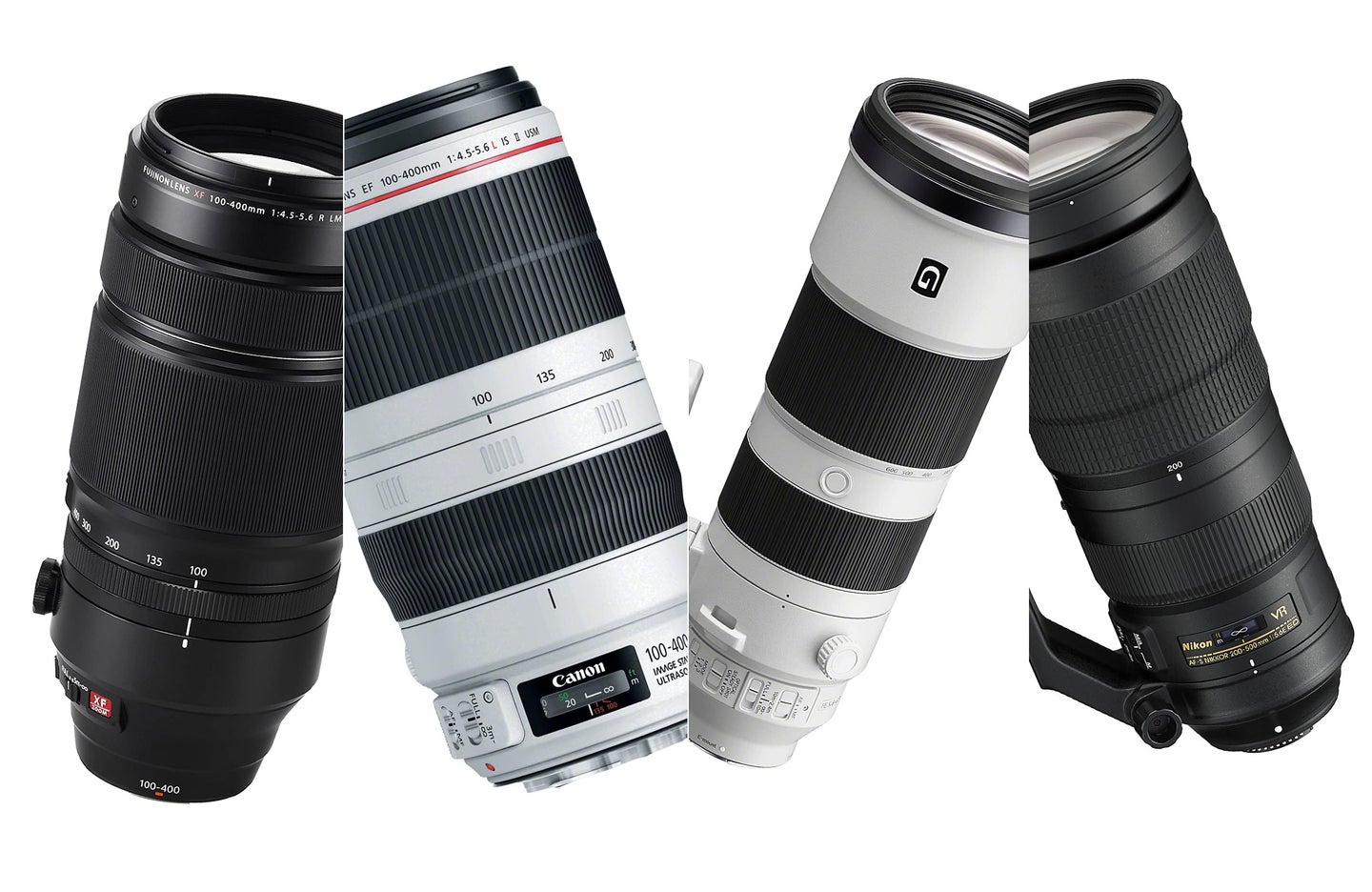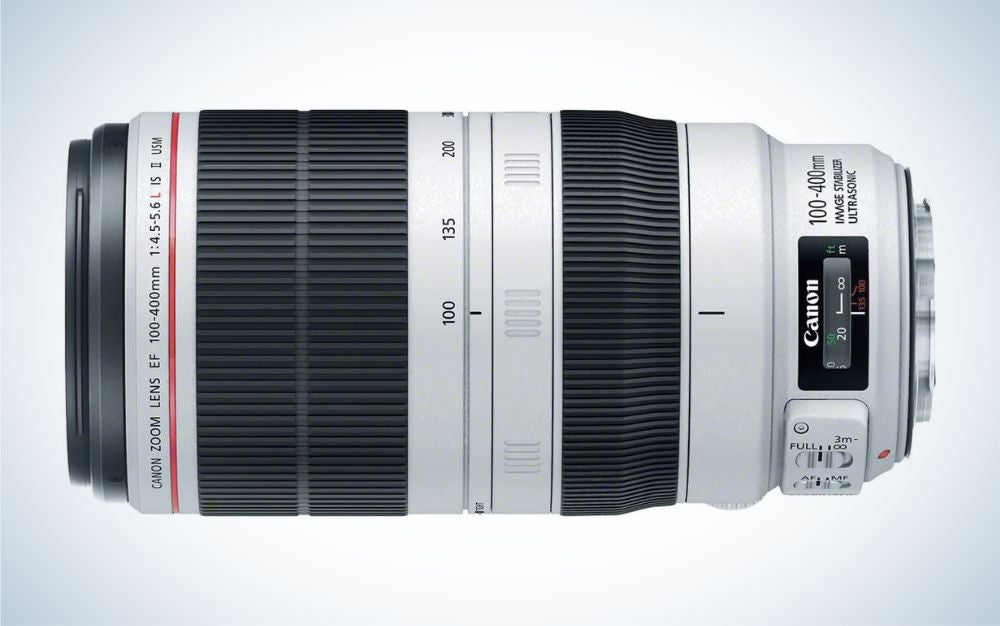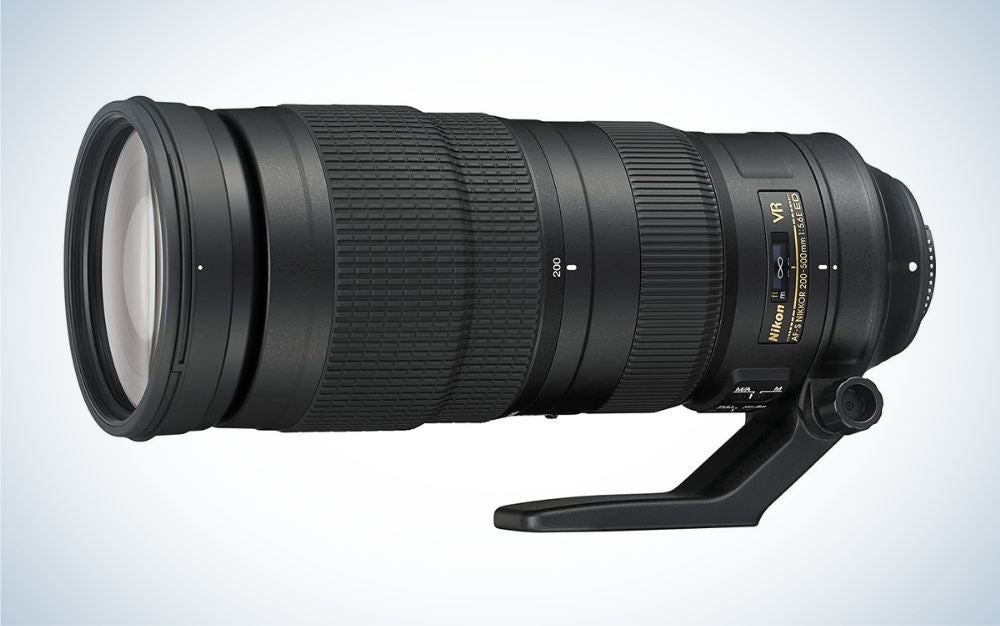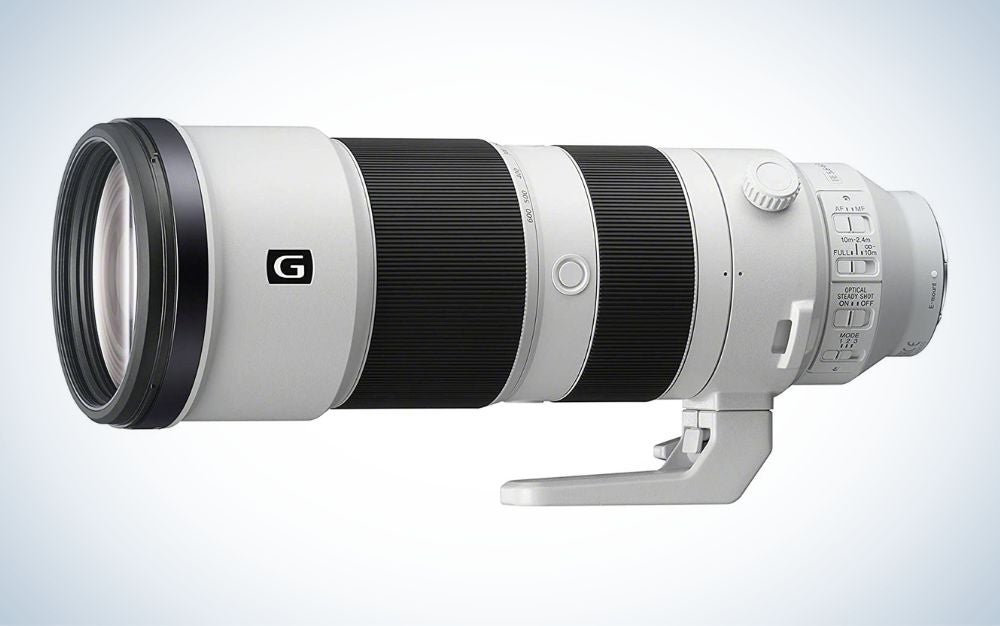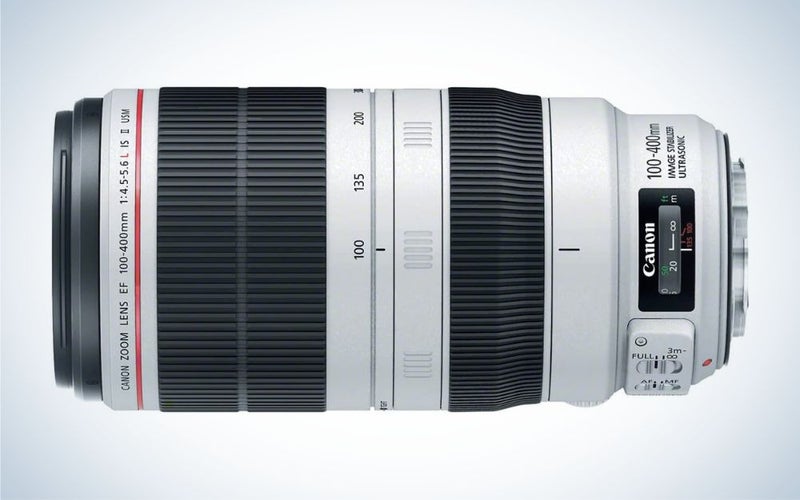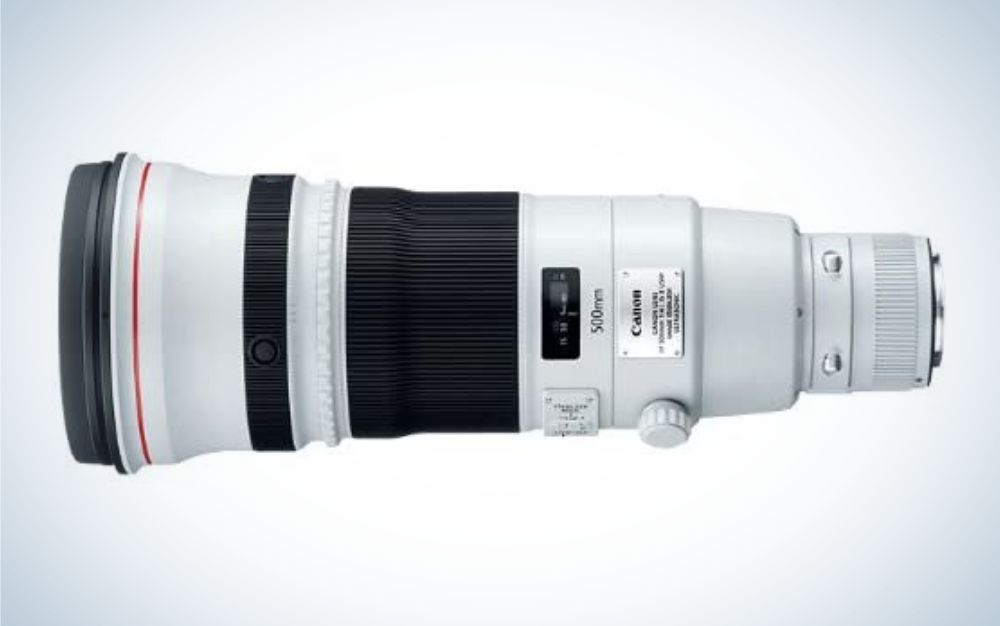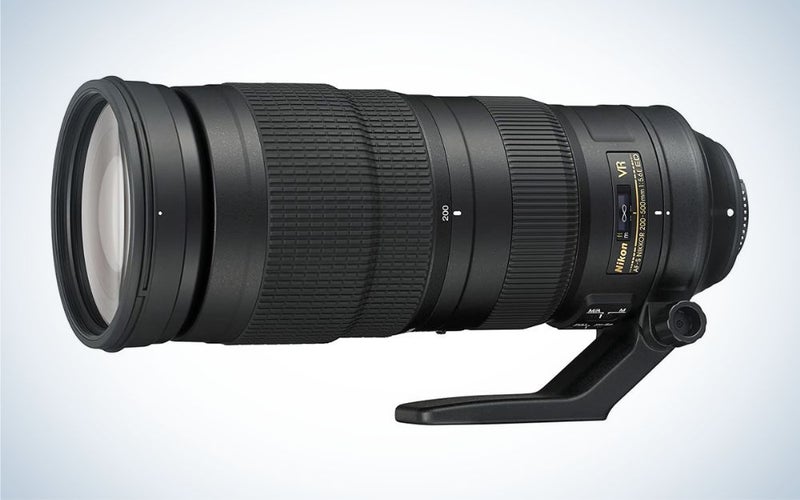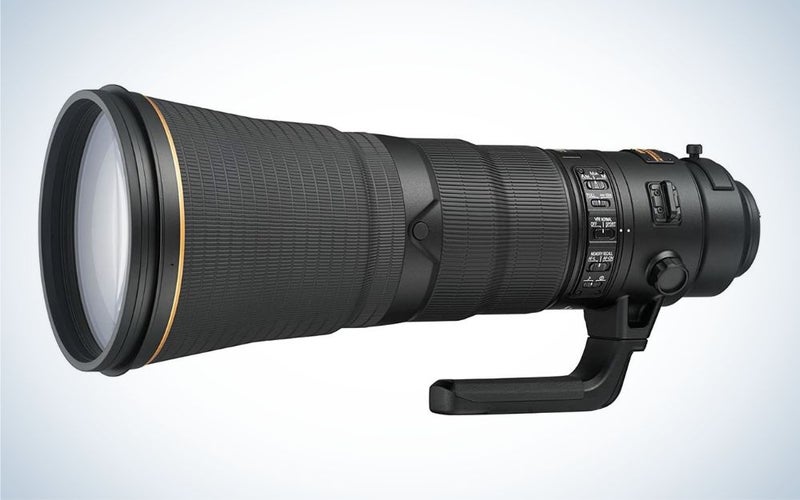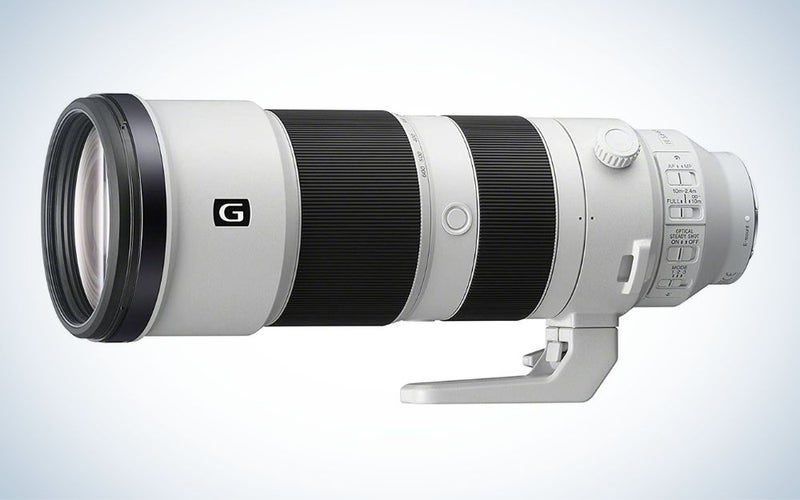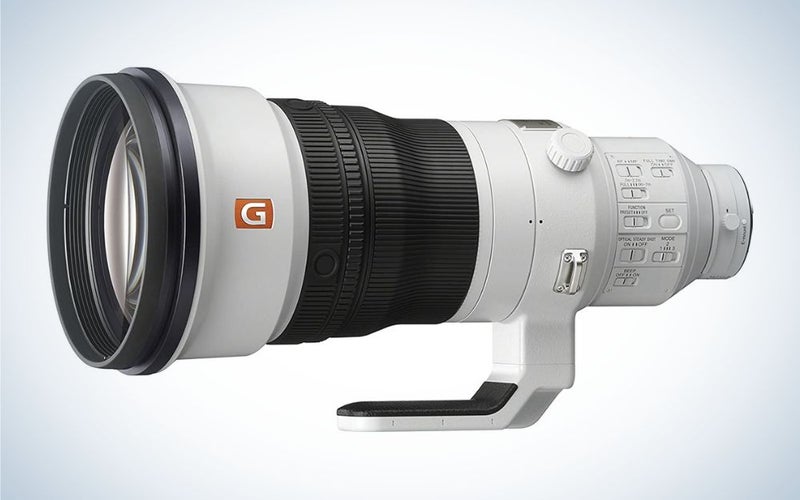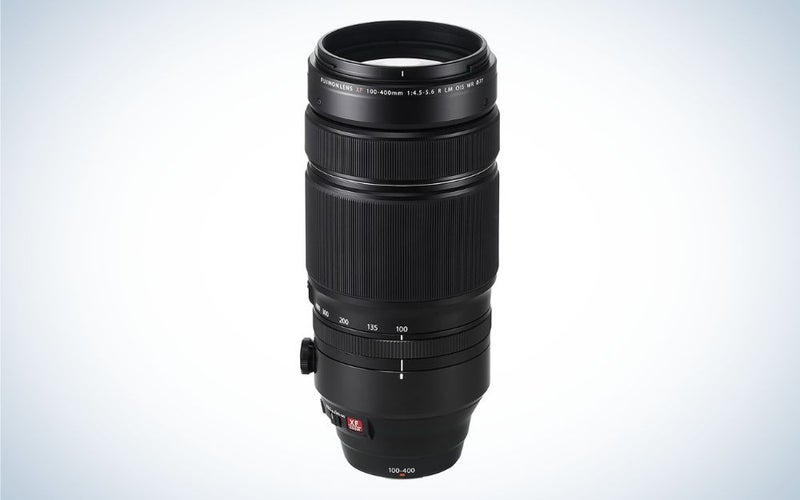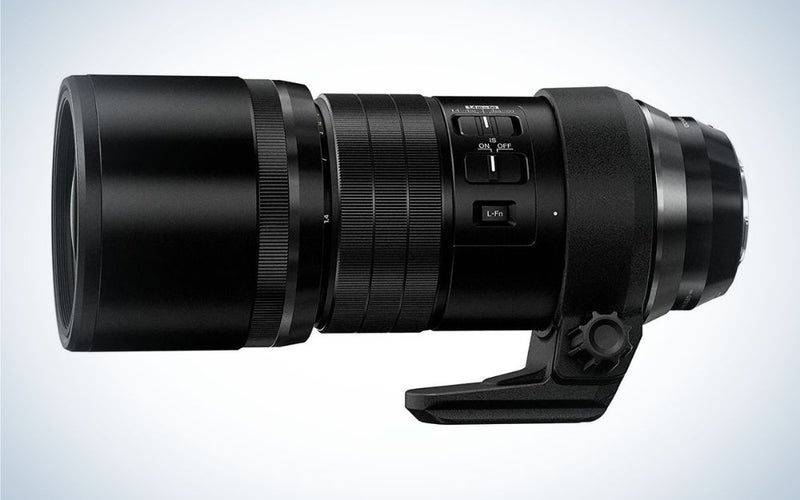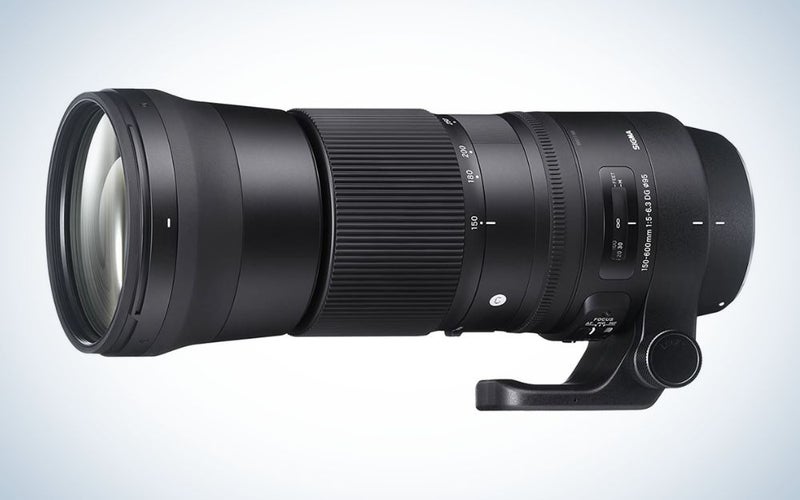We may earn revenue from the products available on this page and participate in affiliate programs. Learn more ›
Documenting avian species can be tricky but the best lenses for bird photography make it much more attainable. Without the proper lens, you may be too far away, risk scaring birds away, or be stuck waiting on the lens to resolve focus. While ultra-telephoto lenses are more niche than other ranges, there is still a wide assortment to consider. But no matter what camera system you use, we’ve found the best lenses for bird photography.
- Best Canon: Canon EF 100-400mm f/4.5-5.6L IS II USM Lens
- Best Canon premium: Canon EF 500mm f/4L IS II USM Lens
- Best Nikon: Nikon AF-S FX NIKKOR 200-500mm f/5.6E ED
- Best Nikon premium: Nikon AF-S FX NIKKOR 600mm f/4E FL ED
- Best Sony: Sony FE 200-600mm F5.6-6.3 G OSS
- Best Sony premium: Sony FE 400mm f/2.8 GM OSS Lens
- Best Fujifilm: Fujifilm XF 100-400mm F4.5-5.6 R LM OIS WR Lens
- Best micro four-thirds: Olympus M.Zuiko Digital ED 300mm f4 IS PRO
- Best budget: Sigma 150-600mm 5-6.3 Contemporary DG OS HSM
How we picked the best lenses for bird photography
The writers and editors at Pop Photo have decades of experience in most genres of photography and with every major camera system available. We used a mix of personal experience, industry insight, editorial reviews, user feedback, and of course, manufacturer-supplied specs to make the selections for the best lenses for bird photography.
Since bird photography relies on a long telephoto lens to get the shot without scaring away the birds, we prioritized lenses with a focal length of at least 300mm. We selected options for every major brand as most will already have a camera system when buying such a lens. We also looked at consumer and professional models to provide a well-rounded lineup. Beyond focal length and brand, we considered low-light performance, weight and size, autofocus abilities, image stabilization, and weather sealing. And, of course, none of those features mean anything if the lens can’t also produce good looking images, so image quality was a primary consideration as well.
Best lenses for bird photography: Reviews & Recommendations
Best Canon: Canon EF 100-400mm f/4.5-5.6L IS II USM Lens
Canon
Why it made the cut: With a rugged build, excellent sharpness, and an ideal zoom range, this Canon lens is ideal for those who want quality but aren’t looking for an ultra-high-end telephoto for bird photography.
Key features:
- Maximum aperture: f/4.5-5.6
- Weight: 3.61 pounds
- Filter size: 77 mm
- Minimum focusing distance: 3.22 feet
Pros
- Ideal zoom range for birding
- Four stops of image stabilization
- Weather resistant design
- Very sharp
Cons
- Heavy
- Pricey
This is the second iteration of the popular Canon EF 100-400mm f/4.5-5.6, and it has many worthwhile improvements from the original version. Canon’s first 100-400 was released way back in 1998 and featured the less-than-ideal push-pull zoom mechanism. Luckily, when Canon updated it in 2014, they changed the zoom to the much-preferred twist style. The upgrade also included a new, weather-sealed design, which is ideal for wildlife photography.
With this lens, you also get four stops of image stabilization to help when shooting in low-light conditions. To fine-tune your settings, there are three image stabilization modes, Standard, Panning, and During Exposure Only. Standard is intended for stationary subjects and results in your view through the viewfinder stabilized. The same is true for Panning, which, as the name implies, is used when tracking a subject moving in a linear manner. The third mode does not allow you to have an image-stabilized view through the viewfinder and instead only applies IS when you release the shutter. It is ideal for more erratically moving subjects.
This lens is a pricey option for the general enthusiast. But it has excellent image sharpness with an ideal zoom range. The autofocus is speedy, quiet, and accurate, meaning you won’t scare the birds away when focusing and can easily get things sharp. It truly is a great zoom lens for birding.
If you are a Canon mirrorless user, the Canon RF 100-500mm F4.5-7.1 L IS USM is a similar option for RF mount. You get an extra 100mm of zoom, though you lose two-thirds of a stop in aperture when you zoom in. And it is more expensive, but as a newer lens, that shouldn’t be too surprising.
Best Canon premium: Canon EF 500mm f/4L IS II USM Lens
Canon
Why it made the cut: For prime lens lovers who want the best quality, this 500mm is a premium option with exceptionally fast and accurate autofocus.
Key features:
- Maximum aperture: f/4.0
- Weight: 7.02 pounds
- Filter size: 52 mm (drop-in)
- Minimum focusing distance: 12.14 feet
Pros
- Excellent image stabilization with three modes
- Exceptional sharpness
- Fast and accurate autofocus
- Weather sealed
Cons
- Expensive
The Canon 500mm is in Canon’s L lineup of lenses, their professional line. And this lens definitely belongs there. It has exceptional image sharpness, even wide open, which isn’t typical. That will help you get quality shots even in low light situations. You get excellent contrast and color saturation thanks to the lens elements and coatings that Canon used. So if you’re photographing colorful birds, they will truly pop.
The autofocus is very fast and nearly silent, so you don’t have to worry about scaring away your feathered friends. There are also many handy autofocus features, such as the focus preset system. If you know you’ll see birds at the same distances repeatedly, you can program those in and quickly recall that focus distance. It also has a focus limiter with three ranges–12.1-32.8 feet, 12.1 feet-infinity, or 32.8 feet-infinity–to prevent the lens from searching for focus unnecessarily.
500mm is an ideal focal length for bird photography. But, should you want more reach, you can also use it on an APS-C camera for an 800mm equivalent angle of view. No matter what camera you use it on, the image stabilization is impressive. Like the lens above, it has three different modes depending on your subject. And the lens is weather sealed for protection against the elements.
Best Nikon: Nikon AF-S FX NIKKOR 200-500mm f/5.6E ED
Nikon
Why it made the cut: It has a constant maximum aperture of f/5.6, an incredibly smooth focus ring, and comes at a very reasonable price for such a big telephoto.
Key features:
- Maximum aperture: f/5.6
- Weight: 5.07 pounds
- Filter size: 95 mm
- Minimum focusing distance: 7.22 feet
Pros
- 4.5 stops of image stabilization
- Lots of quality for the price
- Works well with teleconverters
- Very smooth focus ring
Cons
- Slow to zoom in or out all the way
- Heavy
The NIKKOR 200-500mm f/5.6 is a lot of lens at a relatively affordable price. Telephoto lenses of this range and quality typically are around the $2,000 mark or higher, but Nikon made this option more affordable. It even has a constant f/5.6 maximum aperture, something you don’t see on lenses of this class. It is designed for full frame cameras but also works well on crop sensors. In fact, it would be ideal on a DX camera–such as the Nikon D500–since it would result in an effective focal length of 300-750mm.
This Nikon lens has 4.5 stops of vibration reduction, making it easier to handhold should you want to. There are two VR modes to select from, either Normal or Sport. For most situations, normal will be the best choice. But if you are tracking birds in flight, Sport will help you out.
Like many telephoto zoom lenses, it has a focus limiter. If you know your subject will be consistently in the distance, you can flip that switch, which will keep the lens from searching for focus closer than 20 feet. The autofocus is very accurate and fast in most situations. If you need to, you can turn the focus ring for instant manual focus override; no fumbling with the switch is necessary.
Nikon’s consumer-level telephoto is a heavy one. It weighs almost nearly a pound and a half more than Canon’s version. As a result, it’s not something that you will want to handhold for long periods. But, if you have a tripod or monopod that you can mount it to, it is a fantastic lens, especially for the price.
For Nikon mirrorless users, the Nikon NIKKOR Z 100-400mm f/4.5-5.6 VR S is a great choice, though it is significantly more pricey.
Best Nikon premium: Nikon AF-S FX NIKKOR 600mm f/4E FL ED
Nikon
Why it made the cut: It has jaw-dropping sharpness, quiet and accurate autofocus, and good low light abilities, making it the best birding lens for Nikon.
Key features:
- Maximum aperture: f/4
- Weight: 8.4 pounds
- Filter size: 40.5 mm (drop-in)
- Minimum focusing distance: 14.44 feet
Pros
- Four stops of vibration reduction
- Quiet autofocus is compatible with video work
- Outstanding sharpness across the frame
- Weight is well balanced
Cons
- Heavy
- Very expensive
The update to Nikon’s 600mm super-telephoto was released in 2015 and featured some worthwhile improvements. The main upgrade is weight reduction. Though it is still a heavy lens, Nikon shaved off over three pounds from the original version of this lens. It also improved the balance of the lens. The original 600mm was quite front-heavy, making it challenging to use without a tripod. This new version has a better arrangement of lens elements resulting in better weight distribution. Though you won’t want to hold it for too long because of its weight, it is much more feasible to hand hold it.
Another feature that helps with hand-holding the lens is the four stops of vibration reduction. The VR combined with the fairly wide f/4 maximum aperture makes this lens excellent even in low light conditions. Shooting at dawn or dusk will be no problem. Plus, the autofocusing of this lens is superb, even when light is not plentiful. It is incredibly fast and accurate, which is very useful when capturing skittish birds.
Where this lens really shines is its sharpness. It is truly impressive. The saying, “you get what you pay for,” seems true here. It is an extremely costly lens, but the quality is incredible. You get crisp detail edge to edge. Sharpness is even excellent when completely wide open, so there is no need to stop it down if you want the sharpest images.
Nikon optimized this lens for modern high-resolution cameras, so if you pair it with something like the D850, you will get some amazing results. Unfortunately, there isn’t a super-telephoto option like this for the Nikon Z mount yet, but the converters work well, so you could put this 600mm on the Z9 and still get excellent images.
Best Sony: Sony FE 200-600mm F5.6-6.3 G OSS
Sony
Why it made the cut: This lens amplifies the already impressive autofocus system of Sony cameras. Plus, the 600mm focal length range is beyond what other consumer-focused lenses provide.
Key features:
- Maximum aperture: f/5.6 to 6.3
- Weight: 4.65 pounds
- Filter size: 95 mm
- Minimum focusing distance: 7.87 feet
Pros
- Excellent zoom range
- Internal zoom
- Rugged weather sealing
- Exceptional autofocus
Cons
- No full-time manual focus override
Sony was a bit slow in expanding its telephoto options, especially in the super-telephoto range. So the announcement of the Sony FE 200-600mm F5.6-6.3 G OSS in June of 2019 was a welcome addition, especially for wildlife enthusiasts. One of the more exciting aspects is the fact that it zooms to 600mm, more than other consumer models available. Typically you’d either have to use a teleconverter or spend $8,000 or more to get 600mm, so to get that focal length at a much more budget-friendly price is exciting. And, though it’s designed for full frame cameras, you can use it on APS-C cameras to get an effective focal length range of 300-900mm.
Another worthwhile feature of this lens is the all-internal zoom; when you zoom in or out, the lens doesn’t change in length. At 12.52 inches long, it’s already a long lens, so having that length stay consistent makes it much easier to handle. Also, the zoom ring is exceptionally smooth to rotate. It may even be too smooth for some. It can be easy to bump it to a different focal length while shooting, so you will need to be careful of that.
Sony’s autofocus systems are already very impressive, and this lens pairs very well with that. It is speedy and accurate. And the autofocus is nearly silent, which is a plus for wildlife photography. It’s also a very sharp lens, so you’ll get excellent levels of detail on the birds you photograph.
Even though Sony cameras have great in-body stabilization, this lens also has built-in stabilization (called Optical SteadyShot) for even more low-light assistance. That extra stabilization is helpful since it is a relatively slow lens at f/5.6-6.3. As a result of the slower maximum aperture, the autofocus won’t be quite as responsive in low light, but you will be able to get sharp images free of camera shake even with slow shutter speeds.
Best Sony premium: Sony FE 400mm f/2.8 GM OSS Lens
Sony
Why it made the cut: With a max aperture of f/2.8, fast and accurate autofocus abilities, and great weather sealing, this lens is ideal for tough conditions.
Key features:
- Maximum aperture: f/2.8
- Weight: 6.38 pounds
- Filter size: 40.5 mm (drop-in)
- Minimum focusing distance: 8.86 feet
Pros
- Fast f/2.8 aperture
- Exceptional sharpness
- Excellent autofocusing abilities
- Beautiful bokeh
Cons
- Expensive
Though our other premium lenses provide higher focal lengths, this 400mm is one truly impressive lens. Of course, like the other premium options, you’ll have to pay a pretty penny for it. But, if you want exceptional quality and performance, it is a worthwhile pick.
The wide f/2.8 maximum aperture will help significantly in low-light shooting. Paired with Sony’s Optical SteadyShot (its version of in-lens stabilization) and the in-body stabilization Sony cameras have, this lens is an ideal choice for those tricky lighting situations. You’ll be able to successfully snap away at birds that are most active at first or last light. And like Canon’s lenses, this lens has three stabilization modes for different situations, from stationary to erratically moving subjects.
It is fully weather sealed to protect the lens in rugged conditions, which is ideal for all types of wildlife photography when you are at the whim of Mother Nature. And it weighs only 6.4 pounds, in part thanks to the magnesium alloy build. It’s quite light for a telephoto lens in this range and will be easier to hand hold and carry in your pack on your trips.
Like most of Sony’s lenses, you get some customizable buttons on the lens body. By default, they are focus hold buttons, but you can change that in the camera’s menu to whatever you would rather have fast access to. The focusing on this lens is incredibly fast. It’s able to keep up with the impressive frames per second rate of Sony’s top-tier cameras. And it’s accurate, producing sharp images reliably, even in low light.
The 400mm focal length may be a bit wide for some and is a bit better for showing off some of the environment around the birds. However, it is compatible–and functions well–with FE 1.4x and 2.0x teleconverters for a bit more reach. Or, if you like to shoot tighter, portrait-style images of wildlife without teleconverters, Sony also makes a stunning 600mm f/4 lens.
Best Fuji: Fujifilm XF 100-400mm F4.5-5.6 R LM OIS WR Lens
Fujifilm
Why it made the cut: It has a rugged build, quiet autofocus, and a full-frame equivalent focal length range of 152mm to 609mm, perfect for birding trips in harsher environments.
Key features:
- Maximum aperture: f/4.5 to 5.6
- Weight: 3.03 pounds
- Filter size: 77 mm
- Minimum focusing distance: 5.74 feet
Pros
- Lightweight compared to other options
- Five stops of stabilization
- Fully weather sealed
- Extremely quiet autofocusing
Cons
- A little soft at 400mm
Released in 2016, the XF 100-400mm F4.5-5.6 R LM OIS WR is still Fujifilm’s longest lens. But, given that this lens will be paired with an APS-C camera, you get a full-frame equivalent of 152mm to 609mm, similar to Sony’s zoom offering on our list. At just 3.03 pounds, it is the lightest lens of the bunch we’ve highlighted here. However, it is the heaviest Fuji lens. So if you are a long-time Fuji user, it might take some time to get used to.
One of the nicest features of this lens is its rugged build. It has 13 weather seals in 12 locations to protect against dust and rain. And it can handle temperatures as low as 14°F. So if you are headed into remote locations for your bird photography, this lens will be an excellent choice.
Twin linear motors power the autofocus. It’s quick to focus, even on moving subjects. It’s a focus by wire setup, meaning there are no distance indicators or hard stops on the focus ring, which isn’t everyone’s cup of tea. And unfortunately, there is no full-time manual override option, meaning you’ll have to toggle the autofocus switch on the lens body if you need to make a manual adjustment.
This Fuji lens overall produces sharp, clear images. You will lose some sharpness when shooting wide open and zoomed in all the way, which is unfortunate. But, you can help mitigate that some by stopping down your aperture. It also has five stops of image stabilization, making it excellent in low light situations.
Best micro four-thirds: Olympus M.Zuiko Digital ED 300mm f4 IS PRO
Olympus
Why it made the cut: With 17 separate weather seals, impressive image stabilization, and the lightest weight of any others on our list, this lens is ideal for your rugged, backcountry birding trips.
Key features:
- Maximum aperture: f/4
- Weight: 2.8 pounds
- Filter size: 77 mm
- Minimum focusing distance: 4.59 feet
Pros
- Extremely rugged build
- Six stops of image stabilization when paired with in-camera features
- Precise autofocus
- Relatively lightweight
Cons
- Pricey
Olympus cameras have some of the best weatherproofing available and are meant for serious adventures. Its 300mm f4 IS PRO is built to keep up and has a highly durable build with 17 separate weather seals and freezeproof construction. So should you be photographing penguins in Antarctica, waterfowl in the rainy Pacific Northwest, or the Desert Sparrow in the Sahara Desert, you’ll be able to trust that this lens will hold up.
When paired with the in-camera stabilization settings, you can get a full six stops of image stabilization. That will be hugely beneficial for capturing birds at the crack of dawn, in thick forests, or in other low-light situations. In addition, the max aperture is a decently fast f/4, which will also help with low-light conditions and provide a nice background blur.
Overall the autofocus on this lens is speedy and accurate, though that partly depends on your camera and settings. In some situations, it can struggle, but the included focus limiter switch helps significantly with that. Though not by definition a macro lens, this option can focus closer than any other super-telephoto on our list. If you can get within 4.59 feet of a bird, you could get some nice macro shots of its feathers.
Though it is a bit pricey for consumer-level models, keep in mind it’s the full-frame equivalent of 600mm. Most 600mm lenses will cost you four times as much. Should you want even more reach, Olympus also makes a weather-sealed 1.4x teleconverter which will give you the equivalent of 840mm.
Best budget: Sigma 150-600mm 5-6.3 Contemporary DG OS HSM
Sigma
Why it made the cut: If you want to dip your toes in bird photography but don’t want to spend a small fortune, this Sigma option is much more affordable but still maintains lots of quality.
Key features:
- Maximum aperture: f/5 to 6.3
- Weight: 4.03 pounds
- Filter size: 95 mm
- Minimum focusing distance: 9.19 feet
Pros
- Much more affordable
- Ideal zoom range for birding
- Very sharp
- Good image stabilization
Cons
- Isn’t fully weather sealed
- Some visible chromatic aberration
If you are new to the world of bird or wildlife photography, or maybe just dabble in the genre for fun, you may not want to spend thousands of dollars on a highly specialized lens. If so, the Sigma 150-600mm Contemporary lens is an excellent buy. It is much more affordable than other options but still has plenty of fantastic features.
The 150-600mm lens is a versatile option, allowing you to take images that include some landscape and close-up portrait-style shots of birds. Though Sigma doesn’t specify how many stops of stabilization the lens has, it does have effective stabilization to help get sharp images even at slower shutter speeds. And there are two stabilization modes, one for stationary subjects and one for panning situations.
Images from this lens are very sharp, with just a little bit of softness on the edges as you zoom in. There is some pincushion distortion, but that is easy to correct in editing and won’t be noticeable unless you take architectural photos. Bird photographers won’t have to worry about it. There is also some visible chromatic aberration, which is also easily fixed. The autofocus is fast and reliable, depending on the camera system you use. If you use a camera with a slower autofocus system, you can take advantage of the focus limiter to keep the lens from searching distances you know your subject won’t be.
While the quality won’t be what you get from the best lenses for bird photography that can cost $10,000, it definitely outperforms its low price point. If you do want more quality while sticking with a Sigma lens, they also offer a Sport version of this 150-600mm, which is roughly the same price as the other consumer-focused models above.
Things to consider when shopping for the best lenses for bird photography
Prime or zoom lens
As with any lens choice, you’ll need to decide if you want a prime or zoom lens. Prime lenses have a single fixed focal length and are generally of higher quality. That is why the premium options we’ve selected are prime lenses; they offer better sharpness and generally faster focus. Typically prime lenses are cheaper than zoom, but in the case of specialized, high-end telephoto lenses, that doesn’t necessarily hold true.
On the other hand, Zoom lenses offer a range of focal lengths in a single lens. They provide more convenience over prime lenses since you don’t have to physically change your position or change lenses to get a different perspective.
When deciding between prime and zoom, you’ll need to consider the type of scenarios you will be using the lens and whether you would like to prioritize quality over convenience and cost. For example, if you are going on a trip for your bird photography, a zoom will save you from needing to pack multiple lenses. Plus, the zoom lenses we’ve featured here are more affordable than the primes, making them ideal for those who don’t have a huge budget. But, if you know you want the sharpest quality and budget isn’t a factor, primes may prove the best lenses for bird photography.
Focal length
Once you’ve narrowed your choices to prime or zoom, you can decide on focal length. You’ll absolutely need a telephoto lens for birding, as it is rare to be able to get even remotely close to a bird without it flying away. Of course, situations vary, but for the most part, a focal length between 300 and 500mm will provide the reach you need. For extra flighty (no pun intended) birds that are perched somewhere, 600mm may even be necessary. Some photographers employ tele-extenders, but they can impact lens performance and reduce the amount of incoming light to lower your maximum aperture.
Focusing speed
Since birds move suddenly and quickly, you’ll need a lens that can focus lightning fast. Unfortunately, there isn’t an easily referenced measurement that manufacturers use to talk about focusing speed. It’s also something that is partially controlled by the camera body. Higher-end lenses often employ faster and more advanced motors to facilitate quicker focusing. A key component to getting the best autofocus also involves choosing the best camera for bird photography.
Aperture
The maximum aperture is an important decision with any lens purchase, and that holds true with lenses for bird photography. You’ll find that ultra-telephoto lenses just don’t come with super-wide apertures very often. Instead, wider apertures more so come into play with low light shooting with this focal length range. If you plan on photographing in low light conditions, such as first and last light or dense forests, look for a wider maximum aperture to ensure you can let in enough light. If you’re worried that you won’t get blurry backgrounds with an f/5.6 lens, you shouldn’t be. You typically get great separation from a telephoto lens like this when it comes to subject and background. You don’t need f/2.8 the vast majority of the time.
Weight
Ultra telephoto lenses are not light lenses. Many of the best lenses for bird photography are large and can be rather cumbersome; there is no getting around it. However, some are lighter than others. If you are heading into the backcountry or traveling to photograph birds, look for a lighter lens to save your back as you make your way to your destination.
FAQs
Q: What lenses do bird photographers use?
Bird photographers use ultra-telephoto lenses. These lenses provide excellent magnification, allowing photographers to keep their distance and leave birds undisturbed in their environment. Except in unique situations, standard telephoto lenses will not provide enough magnification, resulting in the bird taking up a very small part of the image or getting scared off because you are too close.
Q: What size lens is best for bird photography?
A lens with a focal length between 300mm and 500mm is the best lens for bird photography. For birds in flight, you can get away with staying at the 300mm end of the spectrum, with 500mm being ideal for stationary birds. However, if you really want exceptional, dramatic bird photographs, a 600mm lens will be excellent.
Q: Is 300mm enough for bird photography?
300mm is enough for bird photography, though it is generally considered the bare minimum. It will work well in a situation where the birds are a bit tamer, and you can be a little closer to them. But, it may not be enough for situations where you have to keep your distance.
Q: What is the best shutter speed for birds?
The best shutter speed for birds will be a fast one. Birds move quickly, so you’ll need a fast shutter speed to freeze their movement in your images. A shutter speed of at least 1/1000 is ideal, though the faster, the better. If the birds you photograph are mostly stationary, you can get away with something slower, but if there is much movement, you will need to stick with a fast shutter speed.
Final thoughts on the best lenses for bird photography
No matter what camera system you use, you will be able to find a high-quality lens for bird photography. Narrowing in on your budget and the ideal focal length for your location type will help you select the best lenses for bird photography.
